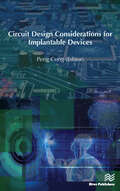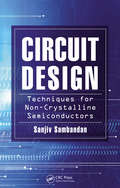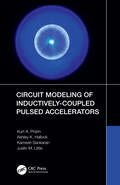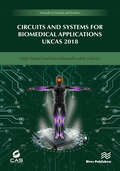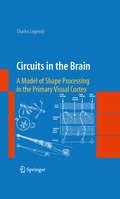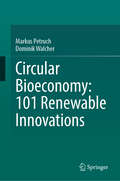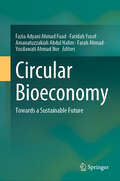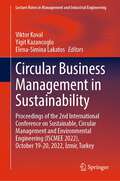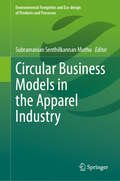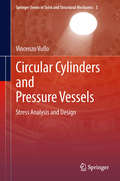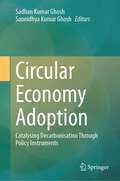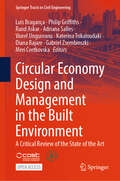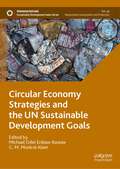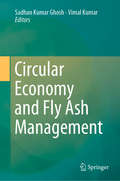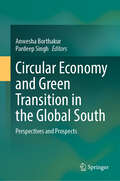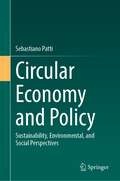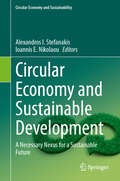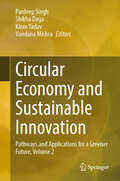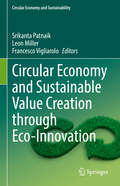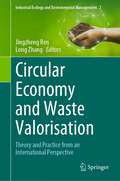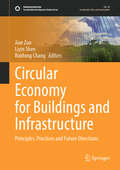- Table View
- List View
Circuit Design Considerations for Implantable Devices
by Peng CongImplantable devices are a unique area for circuit designers. A comprehensive understanding of design trade-offs at the system level is important to ensure device success. Circuit Design Considerations for Implantable Devices provides knowledge to CMOS circuit designers with limited biomedical background to understand design challenges and trade-offs for implantable devices, especially neural interfacing.Technical topics discussed in the book include: Neural interface Neural sensing amplifiers Electrical stimulation Embedded Signal Analysis Wireless Power Transmission to mm-Sized Free-Floating Distributed Implants Next Generation Neural Interface Electronics
Circuit Design Techniques for Non-Crystalline Semiconductors
by Sanjiv SambandanDespite significant progress in materials and fabrication technologies related to non-crystalline semiconductors, fundamental drawbacks continue to limit real-world application of these devices in electronic circuits. To help readers deal with problems such as low mobility and intrinsic time variant behavior, Circuit Design Techniques for Non-Cryst
Circuit Modeling of Inductively-Coupled Pulsed Accelerators
by Kurt A. Polzin Ashley K. Hallock Kamesh Sankaran Justin M. LittleThis monograph describes lumped-element modelling techniques for inductively-coupled pulsed accelerators, starting from the basic physical description of the various processes and then bringing all the pieces together into solutions. Coilguns, inductive pulsed plasma thrusters, and compact toroids have each been individually studied using the methods used in this monograph. This monograph is of interest to researchers and graduate students in physics, engineering, and mathematics presently studying inductively-coupled pulsed accelerators.Features The first book to unify the lumped-element modelling techniques for various inductively-coupled pulsed accelerator implementations. Discussion of modelling different accelerators in a coherent, rigorous manner, demonstrating the similarities and differences for each type. Authored by authorities in the field.
Circuits and Systems for Biomedical Applications: UKCAS 218
by Hadi Heidari; Sara GhoreishizadehCircuits and Systems for Biomedical Applications-UKCAS 2018 covers several advanced topics in the area of Devices, Analog and Mixed-Signal Circuits and Systems for Biomedical Applications. The fundamental aspects of these topics are discussed, and state-of-the-art developments are presented. The book proceeds the 1st United Kingdom Circuits and Systems (UKCAS 2018) Workshop. It addresses multidisciplinary theme areas such as Biosensing, Memristors, next-generation medical diagnostics, neural-inspired circuits, neural implants, neuro-prostheses, prosthetic hand and neuro-rehabilitation. Having perceived the device and circuit assets for such technologies and knowing what challenges these present for the biomedical scientists and engineers, integrated circuits for addressable biosensing are reviewed in the first chapter. The Second Chapter is harnessing the power of the brain using metaloxide Memristors. The third chapter contains construction of an endoscopic capsule for the diagnostics of dysmotilities in the gastrointestinal track. The next three chapters are on neural interfaces: analogue building blocks of neural inspired circuits are described in the fourth chapter while chapter five focuses on circuits for bio-potential recording from the brain. Networked Integrated circuits and their use in creating advanced implantable stimulation systems will be discussed in chapter six. This topic will be completed by circuits and systems for control of Prosthetic Hands in seventh chapter and genetically enhanced brainimplants for neuro-rehabilitation in chapter eight.
Circuits in the Brain: A Model of Shape Processing in the Primary Visual Cortex
by Charles LegéndyDr. Charles Legéndy's Circuits in the Brain: A Model of Shape Processing in the Primary Visual Cortex is published at a time marked by unprecedented advances in experimental brain research which are, however, not matched by similar advances in theoretical insight. For this reason, the timing is ideal for the appearance of Dr. Legéndy's book, which undertakes to derive certain global features of the brain directly from the neurons. Circuits in the Brain, with its "relational firing" model of shape processing, includes a step-by-step development of a set of multi-neuronal networks for transmitting visual relations, using a strategy believed to be equally applicable to many aspects of brain function other than vision. The book contains a number of testable predictions at the neuronal level, some believed to be accessible to the techniques which have recently become available. With its novel approach and concrete references to anatomy and physiology, the monograph promises to open up entirely new avenues of brain research, and will be particularly useful to graduate students, academics, and researchers studying neuroscience and neurobiology. In addition, since Dr. Legéndy's book succeeds in achieving a clean logical presentation without mathematics, and uses a bare minimum of technical terminology, it may also be enjoyed by non-scientists intrigued by the intellectual challenge of the elegant devices applied inside our brain. The book is uniquely self-contained; with more than 120 annotated illustrations it goes into full detail in describing all functional and theoretical concepts on which it builds.
Circular Bioeconomy: 101 Renewable Innovations
by Dominik Walcher Markus PetruchThe 21st century marks a significant transition toward a circular bioeconomy, as society gradually moves away from fossil fuel dependence and explores the potential of renewable resources. This shift extends beyond energy production to encompass the fundamental materials that construct our world—from buildings and infrastructure to common household items. Envision a future where our problematic reliance on fossil fuels evolves into a sustainable relationship with renewable carbon sources, utilizing nature's resources to create a healthier and more climate friendly way of life. This book offers an accessible visual exploration of the emerging biobased economy. Whether you're a designer, entrepreneur, student, or simply curious about sustainable futures – Through clear illustrations and explanations, it introduces readers to an array of materials derived from plants, fungi, algae, bacteria, and cleverly repurposed biological waste. Blending traditional knowledge with modern innovation, the book both explains the principles behind a biobased economy and presents 101 compelling products, materials, and concepts that are shaping our collective future.
Circular Bioeconomy: Towards a Sustainable Future
by Farah Ahmad Fazia Adyani Ahmad Fuad Faridah Yusof Amanatuzzakiah Abdul Halim Yusilawati Ahmad NorThis book highlights the efforts made to realize the concept of ‘Circular Bioeconomy’. It has twelve (12) chapters, focussed on five (5) sections, namely Biomaterials, Environment, Energy, Pharmaceutical and Enzyme Technology. It portrays research, linking ‘Circular Bioeconomy’ to the United Nation’s Sustainable Development Goals (SDGs). The concept of ‘Circular Economy’, including ‘Circular Bioeconomy’, aims to shift the current, essentially linear economic system to a more sustainable one. Accordingly, the key goal of a ‘Circular Economy’ is to slow, narrow and close material resource loops, built on the foundation of renewable energy and non-toxic materials. Further, a sustainable ‘Bioeconomy’ goes beyond simply switching fossil resources with renewable, biological resources. It requires low-carbon energy inputs, sustainable supply chains and promising disruptive conversion technologies for the sustainable transformation of renewable bioresources to high-value bio-based products, materials and fuels. Thus, a sustainable ‘Circular Bioeconomy’ transition will necessitate a set of consistent metrics that fit all products and industries.
Circular Business Management in Sustainability: Proceedings of the 2nd International Conference on Sustainable, Circular Management and Environmental Engineering (ISCMEE 2022), October 19–20, 2022, İzmir, Turkey (Lecture Notes in Management and Industrial Engineering)
by Viktor Koval Yigit Kazancoglu Elena-Simina LakatosThis book gathers research and best-practices concerning the achievement of sustainable development goals in both community generation and business growth. It highlights the organizational aspects relating to the realization of green innovation. It covers models for optimizing the use of both natural and human resources. It reports on assessment methods and advanced models to analyze community and business performance in the context of sustainable development. Further, it proposes solutions to reduce the effects of environmental pollution, increase energy efficiency, and managing resources and waste, to foster sustainable development. Gathering the proceedings of the 2nd International Conference on Sustainable, Circular Management and Environmental Engineering (ISCMEE 2022), held on October 19-20, 2022, as a hybrid event from İzmir, Turkey, this book offers a timely snapshot on circular business management knowledge and methods for both researchers and professionals in the field of engineering management, business and economics, and energy and environment.
Circular Business Models in the Apparel Industry (Environmental Footprints and Eco-design of Products and Processes)
by Subramanian Senthilkannan MuthuThis volume offers a variety of cases dealing with circular business models in the textile and fashion industry. The cases cover the circularity, circular business models relevant to the apparel industry. In addition, this book presents a comprehensive examination of circular economy principles within the textile and apparel industry, emphasizing sustainability and innovation through various lenses.
Circular Cylinders and Pressure Vessels: Stress Analysis and Design (Springer Series in Solid and Structural Mechanics #3)
by Vincenzo VulloThis book provides comprehensive coverage of stress and strain analysis of circular cylinders and pressure vessels, one of the classic topics of machine design theory and methodology. Whereas other books offer only a partial treatment of the subject and frequently consider stress analysis solely in the elastic field, Circular Cylinders and Pressure Vessels broadens the design horizons, analyzing theoretically what happens at pressures that stress the material beyond its yield point and at thermal loads that give rise to creep. The consideration of both traditional and advanced topics ensures that the book will be of value for a broad spectrum of readers, including students in postgraduate, and doctoral programs and established researchers and design engineers. The relations provided will serve as a sound basis for the design of products that are safe, technologically sophisticated, and compliant with standards and codes and for the development of innovative applications.
Circular Economy Adoption: Catalysing Decarbonisation Through Policy Instruments
by Sadhan Kumar Ghosh Sannidhya Kumar GhoshThis edited book brings out a comprehensive collection of information on principle and policy of circular economy. It deals with the general principles, pathways of circular economic development in different countries, use of circular economy in achieving sustainable development goals. The book covers policy instruments that helps implementing resource efficient processes, strategies of implementing circular economy concepts, Decarbonisation, and developing business promoting circular economy principles. The circular economy has gained increasing prominence as a tool which presents solutions to some of the world’s most pressing sustainable development challenges. By addressing root causes, the concept of a circular economy, an economy in which waste and pollution do not exist by design, products and materials are kept in use, and natural systems are regenerated provides promise to achieving SDGs. This book is of interest and use to practitioners, capacity builders and policymakers, entrepreneurs, NGOs, general people, and valuable source of reference to the relevant researchers and students in global markets. As circular economy is gaining momentum and interest in general, the book serves as reading material for undergraduate and graduate students in any field specifically environmental science, waste management, medical science as well as environmental management at national and international level.
Circular Economy Design and Management in the Built Environment: A Critical Review of the State of the Art (Springer Tracts in Civil Engineering)
by Viorel Ungureanu Luís Bragança Meri Cvetkovska Rand Askar Philip Griffiths Adriana Salles Katerina Tsikaloudaki Diana Bajare Gabriel ZsembinszkiThis open access book offers a comprehensive exploration of Circular Economy Design and Management within the Built Environment, presenting a critical review of the current state of the art. Going through multi-level approaches from material usage to urban planning, it meticulously examines strategies for circular building design, criteria, and indicators for circularity. Additionally, it explores practical tools and frameworks, as well as roles and relationships of stakeholders along the entire value chain. Through insightful case studies and critical analysis, readers gain a deep understanding of circularity principles and applications, circularity management models and feedback systems, sustainable practices, and the integration of circularity into technological advancements and digital tools such as BIM. The importance of this book lies in addressing pressing challenges in contemporary architecture and construction, providing a roadmap for sustainable, circular solutions. It tackles the critical need to transition from linear to circular practices, emphasising resource efficiency, waste reduction, and the longevity of structures. By offering practical insights and highlighting successful implementations, the book aims to guide architects, civil engineers, designers, sustainability professionals, and policymakers towards informed decision-making in creating environmentally conscious built environments. Designed for these professionals and researchers, this book serves as a valuable resource for anyone passionate about reshaping the future of our built spaces with a focus on circularity and environmental responsibility.
Circular Economy Strategies and the UN Sustainable Development Goals (Sustainable Development Goals Series)
by G. M. Monirul Alam Michael Odei Erdiaw-KwasieThis book provides novel perspectives to the ongoing global discussions on the UN Sustainable Development Goals (SDGs). Current knowledge on circular economy and the SDGs target in developing and emerging countries are mostly fragmented and empirical evidence is limited. The approach taken in the book is unique as it presents holistic viewpoints about the synergies, opportunities and challenges between circular economy and SDGs targets in developing and emerging countries. The book presents diverse contents on the topic including literature reviews, conceptual discussions, case studies, and empirical analysis.
Circular Economy and Environmental Resilience: Solutions for a Sustainable Tomorrow, Volume 1
by Pardeep Singh Vandana Mishra Shikha Daga Kiran YadavThis book comprehensively covers the contemporary topic of circular economy and its role in promoting environmental resilience and sustainability. It provides extensive coverage by focusing on the existing environmental issues and how circular practices can help mitigate climate change and bring a development that is not only inclusive but also green. It would be thus immensely useful for the industrialists, academicians, researchers and policymakers working in the area of circular practices, sustainability and environmental protection and resilience. The book addresses the issue of environmental resilience and the role that circular economic practices can play in promoting a development that is not only inclusive and green but also sustainable. The book is an immense use to academicians, students, researchers, policymakers and international organisations working in the area of sustainability and circular economy practices.
Circular Economy and Fly Ash Management
by Vimal Kumar Sadhan Kumar GhoshThis book presents a number of innovative uses of fly ash. Fly ash is a fine powder that is a byproduct of burning pulverized coal in thermal power plants. It is a pozzolan – a substance containing aluminous and siliceous material that when mixed with lime and water forms a compound similar to Portland cement. Though fly ash was a problem in terms of its disposal, it now has a variety of uses, such as a prime material in blocks, bricks, and PCC paving, and further applications are being investigated. As such, the recovery and reuse of fly ash wastes plays an important role in the implementation of the circular economy concept. Featuring selected, high-quality research papers presented at IconSWM 2018, the book provides valuable insights for the recycling industries, power plants, researchers, and governments.
Circular Economy and Green Transition in the Global South: Perspectives and Prospects
by Pardeep Singh Anwesha BorthakurThis book is an attempt to address circular economy and green transition potentials and implications with a particular focus on the Global South. Circular economy and green transition have been central themes of environmental policymaking during the recent decades—both in the Global North and the Global South. However, the focus and attention on the topics among the research community have been relatively recent in the emerging economies and developing countries in the Global South. The term, &“circular economy,&” refers to an economic model that aims to minimize waste, make the most of resources and promote sustainability throughout the entire lifecycle of products and materials. Unlike the traditional linear economy, which follows a &“take-make-dispose&” pattern, the circular economy seeks to create a closed-loop system where resources are reused and recycled. The term &“green transition,&” on the other hand, refers to a comprehensive and systemic shift from an economy that heavily relies on fossil fuels and environmentally destructive practices to one that is sustainable, eco-friendly and focused on addressing global climate change implications. Green transition is often considered as a critical approach to achieve a sustainable future and mitigate the adverse impacts of climate change. Circular economy and the green transition are complementary approaches that, when integrated, can lead to a robust sustainable global economy. Both concepts acknowledge the interconnectedness of environmental, economic and social facets and highlight the significance of a systematized change to achieve a better future. We can consider circular economy as a subset of green transition where both share the overarching goal of fostering sustainability and mitigating detrimental environmental impacts.
Circular Economy and Policy: Sustainability, Environmental, and Social Perspectives
by Sebastiano PattiThis book uses economic and policy approaches to highlight sustainability, environmental, and social aspects of the circular economy. It emphasizes the circular economy within the market’s perspective, including the links between consumption and sustainability, and how balances between profitability and environmental sustainability can be attained. The author also uses a life cycle assessment approach to improve and evaluate circular economy strategies to help determine the environmental, social, and economic consequences of a product. The chapters illustrate circular business models and sustainability consumption behaviour in the public sector, while also measuring eco-efficiency and sustainability impacts. The book will useful for students and researchers in environmental and sustainability economics, as well as businesses and government organizations adapting policies to develop environmentally sustainable economic practices.
Circular Economy and Sustainable Development: A Necessary Nexus for a Sustainable Future (Circular Economy and Sustainability)
by Alexandros I. Stefanakis Ioannis E. NikolaouThis book will highlight the role of CE in the sustainability field as it is expressed in the various fields and disciplines and its contribution to building a sustainable society by providing a better understanding of the relevant social and cultural structures and the need for cross-disciplinary knowledge and diverse skills. Such an integrated approach which combines the concept of sustainability in the engineering field to create a CE, has not yet been presented in detail in the published literature, and there are only scattered studies covering only small parts of this holistic approach. Hence, this book will represent a single reference that will provide summarized information and state-of-the-art knowledge on this topic of the future. The book will include chapters showcasing/investigating the relation between circular economy principles and their realization in different engineering fields. This includes theoretical justification, research studies and full-scale case studies. The approach focuses on two distinct levels: macro and micro, on both production and consumption sides.
Circular Economy and Sustainable Energy Materials: A Net-Zero Emissions Approach
by Ngoc Thanh Thuy Tran Jow-Lay Huang Wei-Sheng Chen Shou-Heng LiuAchieving carbon neutrality is crucial for creating a sustainable and resilient future worldwide. The circular economy framework focuses on reducing waste, optimizing resource use, and promoting regenerative practices, thus curbing carbon footprints. Concurrently, sustainable energy techniques, such as harnessing renewable sources, enhancing energy storage, and boosting energy efficiency, contribute to the reduction of greenhouse gas emissions. With a unique emphasis on net-zero emission approaches, this book delves into circular economy principles and sustainable energy materials, offering a comprehensive perspective on climate change challenges. Covers fundamental circular economy principles, from carbon capture to advancements in biomass and hydrogen energy Explores recycling techniques for essential energy materials, including batteries, solar cells, and fuel cells Provides detailed coverage of technologies, processes, and challenges related to achieving sustainability in the energy sector Bridges theory and practical applications Offering a roadmap toward a carbon neutral and net-zero emission future, this book serves as a valuable resource for advanced students, researchers, engineers, and policymakers worldwide seeking solutions to climate change and sustainable development.
Circular Economy and Sustainable Innovation: Pathways and Applications for a Greener Future, Volume 2
by Pardeep Singh Vandana Mishra Shikha Daga Kiran YadavThis volume focuses on practical applications, innovative strategies, and regional case studies showcasing circular economy practices across sectors and geographies. It brings together insights from scholars and practitioners spanning a diverse set of economies. Covering themes such as sustainable finance, agriculture, fashion, healthcare, and e-waste management, the book highlights both challenges and transformative opportunities in implementing circular models. With a blend of policy analysis, quantitative tools, and indigenous knowledge systems, it offers a multidimensional understanding of how circular economy principles can drive sustainable development. This book is an essential read for academics, policymakers, business leaders, and sustainability advocates seeking actionable solutions in the global transition to circularity.
Circular Economy and Sustainable Value Creation through Eco-Innovation (Circular Economy and Sustainability)
by Srikanta Patnaik Francesco Vigliarolo Leon MillerCircular economy and sustainable value creation through eco-innovation are interconnected concepts that revolve around creating a more sustainable and environmentally friendly approach to economic growth and business development. In a world confronted by pressing environmental challenges, the need for sustainable economic practices has never been more urgent. The traditional linear economic model, characterized by the "take-make-dispose" approach, has led to resource depletion, environmental degradation, and social inequalities. In response to these challenges, the concepts of circular economy and eco-innovation have emerged as powerful frameworks for reshaping our economic systems to prioritize sustainability. The circular economy represents a paradigm shift from the linear economic model that has dominated for centuries. Instead of viewing resources as finite and disposable, the circular economy embraces the idea that resources can be kept in circulation for as long as possible, thereby minimizing waste and environmental impact. At the core of the circular economy is the efficient use of resources. This entails reducing resource consumption, reusing products and materials, and recycling to extend the life of resources. Products are designed with durability and ease of repair in mind, ensuring they have a longer lifespan and can be easily maintained. Circular practices aim to restore natural systems and reduce harm to the environment, whether through reforestation, soil regeneration, or sustainable agriculture.
Circular Economy and Waste Valorisation: Theory and Practice from an International Perspective (Industrial Ecology and Environmental Management #2)
by Jingzheng Ren Long ZhangThe authors and editors of this volume state that with the intensive growth of global industrialization and urbanization, the consumption of various resources and materials, such as energy, minerals, and even water, is increasing at an amazing speed, which poses great pressure on material resources. In addition, the massive utilization of materials has led to low efficiency, resulting in great wastes of resources as well as serious environmental pollutions and degradation, which has severely hindered the sustainable development of economy and society. In order to transit to sustainable development, it is necessary to improved resource efficiency, and circular economy and waste valorization are the best alternative ways for achieving this goal. This book aims to provide an in-depth description of circular economy and waste valorization, make assessments for circular economy and waste valorization in different regions and countries and determine the technological pathways and roadmap for achieving circular economy and waste valorization. More specifically: (1) Conceptions and Theories: Concepts and definitions of circular economy and waste valorization and their nexus and contributions to sustainable development. (2) Policy and Practice: Measurement and assessment of performance or sustainability for implementing circular economy and waste valorization. (3) Pathways and Prospects: Identification and prioritization of the barriers, strategies, technologies, and pathways for achieving circular economy and waste valorization. The book systematically and comprehensively introduces the definitions, concepts, framework and nexus of circular economy and waste valorization, analyzes and measures their performance and sustainability and provides the methods for investigating and prioritizing the barriers and strategies and determining the pathways and roadmap for their development.
Circular Economy and its Implementations in Southeast Asia (Frontiers in South and Southeast Asian Development Research)
by Almas Heshmati Pham Khanh NamThis edited volume explores the implementation of the circular economy (CE) in Southeast Asia, a densely populated region with a significant share of global production. It examines the region’s transition from a linear to a circular economy, providing a comprehensive overview of CE applications across various parts of Southeast Asia. The book offers unique and empirical insights into the approaches, methods, laws, and policies that facilitate the transformation to a CE. It highlights how recent research, trends, and attitudes can be practically oriented towards sustainable development. By linking environmental theory with practice, the book provides practitioners with a deeper understanding of CE and the challenges involved in its implementation. A timely and practical guide, this book is essential for sustainability researchers and policymakers in Asia striving to achieve CE and sustainable development goals. It presents an up-to-date picture of Southeast Asia’s fast-growing economy, showcasing the region’s heavy investment in development infrastructure and cooperative efforts towards environmental sustainability. Authored by professionals with deep insights into the region’s economy and development potential, the chapters offer empirical, research-based perspectives on recent economic trends. This volume fills a crucial knowledge gap regarding Southeast Asian economies, their environmental conditions, and development potential. It also guides emerging economies like Vietnam in sustainable development, helping them avoid the pitfalls of environmental missteps in production, resource utilization, and consumption.
Circular Economy for Buildings and Infrastructure: Principles, Practices and Future Directions (Sustainable Development Goals Series)
by Liyin Shen Jian Zuo Ruidong ChangThis edited volume covers theoretical and practical aspects of circular economy in building development, offering chapters dealing with topics such as material design, affordability of housing development, waste management and recycling, smart metering, and more. A particular focus is placed on various stakeholders’ points of view. The book's chapters are co-developed and contributed by multidisciplinary teams including both academics and industry practitioners. The case study-oriented approach taken here helps to facilitate the reader's understanding of how building sustainability can be achieved in the context of circular economy. The building industry has significant environmental, social and economic impacts. As one of the biggest energy consumers and carbon emitters, building sustainability has attracted wide attention globally. Building projects and their associated activities consume a large amount of energy, natural resources and water while producing a large proportion of wastes throughout their lifecycles. The traditional linear approach of “make, use and dispose” has been heavily criticized, whilst the circular approach has gained momentum. Indeed, circular economy has emerged as one of key principles to manage sustainability related issues by means of focusing on the circularity of resources as well as the cost implications.
Circular Economy for Renewable Energy (Green Energy and Technology)
by Viktor Koval Piotr OlczakThis book explores the role of renewable energy sources in driving sustainable development, with a focus on their circular use in achieving environmental efficiency and an energy balance. The authors highlights the significance of renewable energy in reducing costs for producers and consumers while also ensuring the production of clean energy that can be integrated seamlessly into the national power grid without compromising reliability or energy security.Readers are introduced to the circular economy model and its importance in the context of renewable energy. The book sheds light on the challenges associated with transitioning to alternative energy systems, particularly in cases where not all resources can be fully circulated. Through the research presented in this book, stakeholders will gain insights into how the sustainable renewable energy supply chain can be adapted within the circular economy. This will have a synergistic effect in reducing carbon emissions, and also aid in the production of renewable energy equipment.
